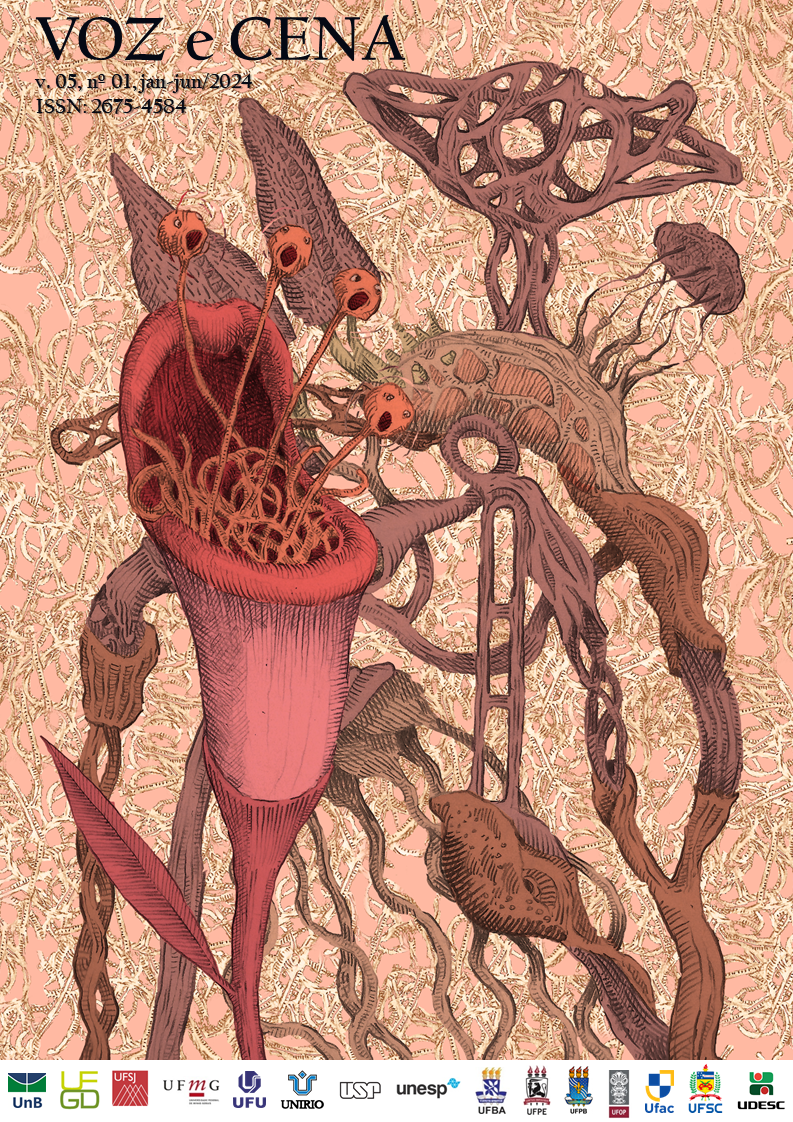Toco-respiro-me muevo-vocalizo-hablo
logos somáticos hacia la atención social
DOI:
https://doi.org/10.26512/vozcen.v5i01.54583Palabras clave:
Prácticas somáticas, Logos somático, Asistencia social, Intercorporalización, Práctica como InvestigaciónResumen
Este artículo desarrolla el concepto de la autora de logos somático como un marco práxico intercorporalizado que facilita las interrelaciones entre voces individuales y colectivas. La autora se basa en su proyecto de Práctica como Investigación (PaR), From Haptic Deprivation to Haptic Possibilities, y utiliza los talleres grupales de ¿Are We Still in Touch? como estudio de caso. Los talleres investigan cómo el contacto autodirigido (iniciado y gestionado por la propia persona) puede fomentar una sensación de cuidado, bienestar y expresión creativa en medio de los cambios sociales catalizados por la pandemia. Los hallazgos de la investigación sugieren que la escucha somática a uno mismo se extiende a un sentido intercorporalizado de cuidado con el potencial de un impacto social más amplio.
Descargas
Citas
AHMED, Sara; STACEY, Jackie. Introduction: dermographies. In: AHMED, Sara; STACEY, Jackie (eds.). Thinking through the skin. London: Routledge, 2004. pp. 1-17.
BAINBRIDGE COHEN, Bonnie. Introduction to Body-Mind Centering. In: MILLER, Gill Wright; ETHRIDGE, Pat; MORGAN, Kate Tarlow (eds.). Exploring Body-Mind Centering: an anthology of experience and method. Berkeley, California: North Atlantic Books, 2011. p. 3-11.
BELLARD, Asleigh et al. Vicarious ratings of self vs. other-directed social touch in women with and recovered from Anorexia Nervosa. Scientific Reports, v. 12, article n. 13429, August 2022. Available at: https://doi.org/10.1038/s41598-022-17523-2. Accessed in: June 21, 2024.
BOEHME, Rebecca; OLAUSSON, Hakan. Differentiating self-touch from social touch. Current Opinion in Behavioral Sciences, Elsevier, v. 43, p. 27-33, February 2022. Available at: https://doi.org/10.1016/j.cobeha.2021.06.012. Accessed in: June 21, 2024.
CHARI, Anita. Vocal resonance and the politics of intercorporeality. In: KAPADOCHA, Christina (editor). Somatic voices in performance research and beyond. Abingdon, Oxon: Routledge, 2021. p. 198-211.
DRURY, Lindsey. What’s in a name? Somatics and the historical revisionism of Thomas Hanna. Dance Research Journal, Cambridge, Cambridge University Press, v. 54, n. 1, p. 6-29, April 2022.
EDDY, Martha. Introduction and overview: the what and why of somatic education. In: EDDY, Martha. Mindful movement: the evolution of the somatic arts and conscious action. Wilmington, North Carolina: Intellect, 2016. p. 3-20.
FARNELL, Brenda. Dynamic embodiment for social theory: ‘I move therefore I am’. Abingdon, Oxon: Routledge, 2012.
HANNA, Thomas. Bodies in revolt: a primer in somatic thinking. New York, Holt Rinehart and Winston, 1970.
HANNA, Thomas. The field of somatics. Somatics: Journal-Magazine of the Bodily Arts and Sciences, Novato, California, Novato Institute for Somatic Research and Training, v. 1, n. 1, p. 30-34, Autumn 1976.
JOHNSON, Don Hanlon. Introduction: borderlands. In: JOHNSON, Don Hanlon (ed.). Diverse bodies, diverse practices: towards an inclusive somatics. Berkeley, California: North Atlantic Books, 2018. p. 7-26.
KAPADOCHA, Christina (ed.). Somatic voices in performance research and beyond. Abingdon, Oxon: Routledge, 2021a.
KAPADOCHA, Christina. Somatic logos in physiovocal actor training and beyond. In: KAPADOCHA, Christina (ed.). Somatic voices in performance research and beyond. Abingdon, Oxon: Routledge, 2021b. p. 155-168.
KAPADOCHA, Christina. Tactile renegotiations in actor training: what the pandemic taught us about touch. Theatre, Dance and Performance Training, Abingdon, Oxon, Routledge, v. 14, n. 2, p. 201-215, June 2023.
MACPHERSON, Ben. The somaesthetic in-between: six statements on vocality, listening and embodiment. In: KAPADOCHA, Christina (ed.). Somatic voices in performance research and beyond. Abingdon, Oxon: Routledge, 2021. p. 212-226.
MERLEAU-PONTY, Maurice. The visible and the invisible. Translated by Alphonso Lingis, edited by Claude Lefort. Evanston, Illinois: Northwestern University Press, 1968.
NELSON, Robin. Practice as research in the arts: principles, protocols, pedagogies, resistances. Basingstoke: Palgrave Macmillan, 2013.
PEZZULLO, Pheadra. Resisting Carelessness. Cultural Studies, Abingdon, Oxon, Taylor and Francis, v. 36, n. 3, p. 507-509, December 2020.
STENSTAD, Gail. Merleau-Ponty’s logos: the sens-ing of the flesh, Philosophy Today, v. 37, n. 1, p. 52-61, 1993.
Descargas
Publicado
Cómo citar
Número
Sección
Categorías
Licencia
Derechos de autor 2024 Voz e Cena

Esta obra está bajo una licencia internacional Creative Commons Atribución 4.0.
Los lectores tienen la libertad de descargar, imprimir y usar los artículos publicados en el periódico, siempre y cuando haya una mención explícita a los autores y al periódico Voz e Cena y que no hay cambio en el trabajo original. Cualquier otro uso de los textos debe ser aprobado por los autores y el periódico. Al enviar un artículo al periódico Voz e Cena y una vez aprobado, los autores acuerdan asignar, sin remuneración, los derechos de primera publicación y el permiso para que el periódico redistribuya este artículo y sus metadatos a los servicios de indexación y referencia que sus editores consideren apropiados.
Este trabajo tiene licencia bajo una Creative Commons Attribution 4.0 International License.![]()


7.PNG)


